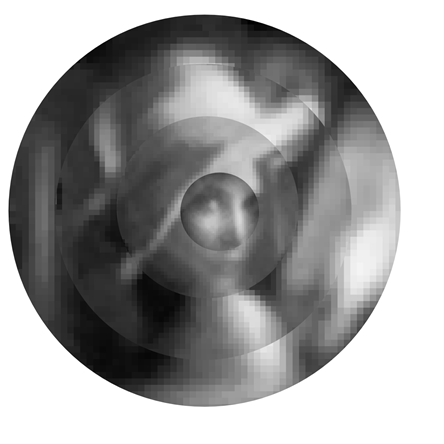Image sensor size comparison. Each of the white dots in the center are lenses, only about 30 microns in size. Image: Thiele et al/Science Advances
Researchers at Germany's University of Stuttgart have designed a new miniature camera inspired by the incredibly precise vision of eagles and other high-flying predators, which is also capable of being 3D printed directly onto a chip. Besides serving as a testament to recent advances in 3D printed micro-optics, the new camera could find a wide variety of uses for everything from surveillance drones to the endoscopic tools used to photograph your insides.As detailed in a paper published Wednesday in Science Advances, the technical name for the system is 'foveated imaging,' which is named after the area in the eye called the fovea.The fovea is a small indent in the retina of the eye which has a high concentration of retinal cones—one of the three types of photoreceptor cells in the human eye—and the area where the center of vision is focused. Many animals have a fovea in their eye, but the efficacy of the fovea varies greatly. For instance, the human fovea contains about 200,000 cones per millimeter, whereas an eagle fovea has around 1,000,000 cones per millimeter.Regardless of their sensitivity, fovea-inspired camera lenses operate on the same principles: they have a wild field of vision which a really low resolution toward the edge of the image, but increasingly high resolution toward the center of the photo. So when looking through a foveated lens, you're going to see something like this: The idea behind foveated lenses is that most tasks do not require total clarity across the entire field of view. This would be much more resource intensive when really, the most important part of what someone is looking at is what is right in the center, where the fovea's resolution is highest.The camera developed by the Stuttgart team actually consists of four different lenses. Each lens has a different focal length—the distance between the point where incoming light converges to form a condensed image and the camera's digital sensor—which have a field of view ranging from 20 to 70 degrees. This means that the camera can capture images at low and high resolution simultaneously, and when these images are overlaid, it creates a foveated image like the one seen above (the narrowest focal length in the center and the widest at the edges).According to the researchers, this new foveated lens design could potentially outperform a normal camera of similar size in terms of image quality, and is thus a good candidate for use in microdrones or vision sensors for robotic arms and self-driving cars.When coupled with the ability to 3D print these types of lenses directly onto a chip, it could also allow them to be mass produced with relative ease since all the aspects of normal lens assembly are consolidated in the 3D printing process (at this point though, it still took about 1-2 hours to print each of the four lenses). In the meantime, the researchers want to figure out how to improve their lens, which might involve adding an anti-reflective coating to the lens to help avoid ghost images and other irregularities caused when light hits microlenses at some angles.Get six of our favorite Motherboard stories every day by signing up for our newsletter.
The idea behind foveated lenses is that most tasks do not require total clarity across the entire field of view. This would be much more resource intensive when really, the most important part of what someone is looking at is what is right in the center, where the fovea's resolution is highest.The camera developed by the Stuttgart team actually consists of four different lenses. Each lens has a different focal length—the distance between the point where incoming light converges to form a condensed image and the camera's digital sensor—which have a field of view ranging from 20 to 70 degrees. This means that the camera can capture images at low and high resolution simultaneously, and when these images are overlaid, it creates a foveated image like the one seen above (the narrowest focal length in the center and the widest at the edges).According to the researchers, this new foveated lens design could potentially outperform a normal camera of similar size in terms of image quality, and is thus a good candidate for use in microdrones or vision sensors for robotic arms and self-driving cars.When coupled with the ability to 3D print these types of lenses directly onto a chip, it could also allow them to be mass produced with relative ease since all the aspects of normal lens assembly are consolidated in the 3D printing process (at this point though, it still took about 1-2 hours to print each of the four lenses). In the meantime, the researchers want to figure out how to improve their lens, which might involve adding an anti-reflective coating to the lens to help avoid ghost images and other irregularities caused when light hits microlenses at some angles.Get six of our favorite Motherboard stories every day by signing up for our newsletter.
Advertisement

